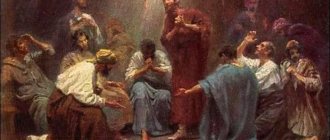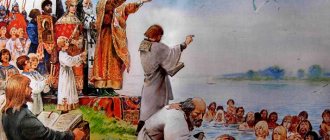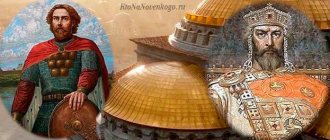In search of the One God
The idea of a single spiritual origin of the world is familiar to many ancient teachings. The philosophical justification for this idea is also given in the writings of Plato, to whose views the main provisions of the fundamental doctrine of Christianity go back.
Plato writes about the existence of three substances - the One (Good), Mind and Soul. The fundamental level of the universe is the One - beginningless, endless and qualityless being, which contains countless eidos - prototypes, principles, ideas of all things. The generation of the One is Mind (Nus) - the eternal law that creates and harmonizes the universe. The world soul ensures the influence of ideas on the material world; its image and creation are the individual souls of people.
Matter, in itself absolutely formless and irreducible to any physical elements, is the “receiver” and “nurse” of ideas. Matter is not a truly existing thing - its unsteady, changeable existence comes down to reflecting ideas and “participating” in the formation of things. Thus, empirical reality is opposed by the highest, perfect and eternal world, the abode of prototypes and meanings.
Knowledge, according to Plato, is the recollection of souls about their heavenly homeland. In moments of creative ecstasy, the energy of cosmic Eros allows one to ascend from bodily love to spiritual love, and from the latter to the contemplation of the One Good.
Plato's concept, developed in detail by his followers in the Hellenistic period, became a kind of “rough sketch” for the Christian doctrine of the Trinity.
Philo of Alexandria (1st century AD) combined the concept of Logos in the Jewish and Hellenistic traditions - as the Word of God, embodied in the scriptures, and as the law that generates the Cosmos and keeps it from destruction. The philosopher’s attempts to interpret the Torah through the prism of Hellenic philosophy were rejected by normative Judaism as incorrect, but were taken up by a number of Christian apologists who sought to emphasize the kinship of Jewish and Christian faiths.
Following Philo, apologists began to use the method of arbitrary allegorical interpretation of the Old Testament writings, allowing them to ignore their literal meaning - simple and understandable, but often contrary to the norms of Christian ethics. As a result, the texts of the New Testament were overgrown with numerous references to the Hebrew code. The meaning of some of them is difficult to understand even for a highly trained reader. For example, the statement: “Blessed are the pure in heart, for they will see God” (Matthew 5:5) is accompanied by a reference to Psalm 136:8-9: “Daughter of Babylon, O desolator! Blessed is he who repays you for what you have done to us! Blessed is he who takes and dashes your babies against a stone!”, from which we have to conclude that he who smashes the Babylonian babies against a stone is pure in heart.
Christianity adopted Philo’s ideas about the original sinfulness of people, the need for repentance, etc. The philosopher’s teaching about the Son of God as the highest logos and about other logos called angels formed the basis of Christian ideas about the hierarchy of spiritual principles.
The works of Plotinus (III century) formed the basis of medieval religious philosophy (Blessed Augustine and others). In particular, Christian theologians shared Plotinus's ideas about time as an image of eternity.
For Plotype, time appears as an other being of eternity, its moving image. But in comparison with pure eidos, it is also involved in becoming, and therefore it is living eternity, or eternal life.
The philosopher proves that the One necessarily resides in everything. Everything “flows out” from it, without loss of the originator and without the participation of his will (for he is impersonal), but solely due to his inner nature. Pure essence can only be realized through something else - the One acts through the Mind. The semantic embodiment of the Mind beyond its limits is the Soul, or the “lotus of the mind.” Following Plato, Plotinus speaks of the immortality of the individual soul, of its descent to earth and subsequent departure to heaven, of knowledge as recollection, etc.
The Roman Stoic Seneca (1st century AD), whose views are in many ways consonant with the ethical teachings of Christianity, writes about the need to submit to the world’s Reason. According to Seneca, every person should strive to achieve freedom of spirit by realizing divine necessity. Obedience to the higher will allows you to achieve equanimity of spirit, and in addition, it ensures harmony in society, as it underlies conscience and moral standards. If freedom does not flow from divine necessity, it becomes slavery. Only freedom limited by conscience is true freedom.
Seneca proves that relationships between people should be built on mutual love, compassion, and the care of each person for others like him, regardless of their social status - after all, by nature, all people are one. The “golden rule of morality” formulated by the philosopher is as follows: “Treat those below you the way you would like to be treated by those above you.” Wed. in the Gospel of Matthew: “And in all things, as you would have people do to you, do so to them.”
Christianity is also close to Seneca’s thoughts about the transience of earthly existence, about the deceitfulness of sensual pleasures, about the need to resist the rampant passions, about otherworldly retribution, etc.
§ 3. Sources of Christian doctrine
The source of Christian doctrine and truth, revealed in Dogmatic Theology, is the supernatural revelation of God. It is given to us in Holy Scripture and Holy Tradition, the guardian and interpreter of which is the Church. The name Holy Scripture refers to books written under the inspiration of the Spirit of God by God-enlightened people - prophets and apostles. The collection of these books is called the Bible, which contains a total of 77 books. The Bible is divided into the Old and New Testaments. The total number of Old Testament books in the Orthodox tradition is 50: of these, 39 books are called canonical (in the Jewish tradition they are combined into 22 books) and 11 are non-canonical. The New Testament consists of 27 books. A distinctive feature of canonical books is their Inspiration, that is, they were written by special illumination and enlightenment from the Holy Spirit and therefore are not only free from error, but also contain the Revelation of Divine truth. The inspiration of the sacred books is clearly attested to by their very content. They 1) reveal to us the secrets of Divine life, that is, such truths that the human mind itself could not and cannot reach on its own. In addition, they 2) contain prophecies, that is, predictions about distant and often miraculous events of the future, which no human mind has been able to foresee for hundreds and thousands of years. Finally, in the sacred books there are 3) direct indications of their Inspiration. Thus, they constantly contain the expressions: “the Lord said to me,” “the word of the Lord came to me,” etc. The Lord Himself says about David that “the Lord said to my Lord, Sit on my right hand” (Mark 12:36). The Apostle Peter also says about the Old Testament writers that “For prophecy was never made by the will of man, but holy men of God spoke” (2 Peter 1:21). And the Apostle Paul decisively testifies to his beloved disciple Timothy: “All Scripture is inspired by God and profitable for teaching” (2 Tim. 3:16). About the New Testament writings, the holy Apostle Paul says: “We have not received the Spirit of this world, but the Spirit who is from God, that we might know the things freely given to us by God, which we speak not in words taught by human wisdom, but in words taught by the Holy Spirit” (1 Cor. 2: 12-13). The apostle expresses the same thought when he says that they, the apostles, “have the mind of Christ,” that their preaching is not the word of man, but truly the word of God, that they preach “the wisdom of God, secret, hidden, which God destined before the ages for glory.” ours” (1 Cor. 2:7) or when he depicts the extraordinary beneficial effect of the Gospel preaching on the human soul with these words: “for the word of God is living and active and sharper than any two-edged sword: it penetrates to the dividing of soul and spirit, joints and marrow, and judges thoughts and intents of the heart" (Heb. 4:12). These books, containing the “verbs of eternal life,” are the first and main source of the truth of Christian doctrine in general and, above all, dogmas. Sacred Tradition The second source of Christian doctrine is Sacred Tradition. The name of Holy Tradition, in the proper or narrow sense of the word, means the Revelation of God, received by the apostles from Jesus Christ and transmitted to the Church by the inspiration of the Holy Spirit by the apostles themselves, in addition to the Holy Scriptures. It is known that the Holy Scriptures of the New Testament do not record everything that Jesus Christ did and taught. The Holy Apostle John at the end of his Gospel admits: “Jesus did many other miracles before His disciples, which are not written in this book” (John 20:30). These sayings of the Lord, not recorded in the Holy Books, the so-called “agrafa” and His instructions, preserved and transmitted orally by the Apostles of the Church, constitute the Holy Tradition in the proper sense of the word. For the knowledge of Christian truth, it, as the word of God, has the same importance and meaning as the Holy Scriptures. Therefore, the Apostle Paul directly commands: “Therefore, brethren, stand fast and hold to the traditions which you have been taught either by word or by our epistle” (2 Thessalonians 2:15), and turning to his beloved disciple Timothy, he says: “O Timothy! Keep what is given to you, turning away from worthless idle talk and the contradictions of false knowledge" (1 Tim. 6:20). And in the Second Epistle to the Corinthians, he praises the Corinthian Christians for holding firmly to the tradition: “I praise you, brethren, because you remember everything that is mine and keep the traditions as I handed them down to you” (1 Cor. 11:2). Tradition in the general or broad sense must be distinguished from Tradition in the narrow sense of the word, by which is meant the storage of Divine Revelation in letter and interpretation or understanding of it in spirit and meaning. The Church founded by Christ, being the pillar and affirmation of the truth, preserves and transmits from century to century the Divine Revelation intact and intact - in the form in which it was given to it by God. At the same time, she keeps within herself and transmits from century to century her understanding or understanding of Divine Revelation and, thus, is the infallible custodian and interpreter of Divine Revelation and, in particular, the Holy Scriptures. Tradition in the broad sense is obviously not the source of Divine revelation, like Tradition in the narrow sense, but it is a necessary guide to the use of Divine revelation and the correct understanding of the truths given in revelation. Tradition in this sense is the testimony or voice of the Universal Church, otherwise it is that spirit of truth and faith, that consciousness of the Church that has lived in it since the time of Christ and the apostles. The voice of the universal Church about the truths of faith finds its external expression: a) in the most ancient symbols of faith; b) in the so-called apostolic canons, in the acts and decrees of councils, both ecumenical and local; c) in ancient liturgies; d) in the works of the ancient fathers and teachers of the Church; e) in the most ancient acts of martyrdom; f) in all the practice of the ancient church and in general in the surviving church rites.
| Forward |
Theology and anthropology
Unlike the Jewish Yahweh and the Muslim Allah, who combine creative and destructive forces, the Christian God the Father is conceived as pure love, the ontological source of all love is the inexplicable Light, in which “there is no darkness.” “Do not call God fair,” writes Isaac the Syrian, “for if God is fair, then I am lost. Christianity is the path of love that is above the law: God can forgive where karma should punish.” The Christian God does not curse or execute, but blesses and “suffers together with every sufferer... and dies in every dying person... in the history of Jesus Christ the mystery of God was revealed: He suffers with us” (G. Pomeranets). The Son of Man did not come to judge people, but to save them (John 3:17). The idea of a loving God, the idea of love as the basis of the world is the main idea of Christianity, the main “message” (kerygma) of Christ to humanity:
“If I speak in the tongues of men and of angels, but do not have love, then I am a ringing gossamer, or a sounding cymbal. If I have the gift of prophecy, and know all mysteries, and have all knowledge and all faith, so that I could move mountains, but do not have love, then I am nothing. And if I give away all my property and give my body to be burned, but do not have love, it will be of no benefit to me. Love endures for a long time, is merciful, love does not envy, love does not exalt itself, is not proud, does not act outrageously, does not seek its own, is not irritated, does not think evil, does not rejoice in unrighteousness, but rejoices in the truth... Love never ceases, although the prophecies will cease, and tongues will fall silent, and knowledge will be abolished,” these are the words of the Apostle Paul that sound from the lips of the great Russian icon painter in A. Tarkovsky’s film “Andrei Rublev” (perhaps the best that has been created in cinema on a Christian theme).
The God of Christians has no ethnic preferences, no chosen people: “Christ’s Grace embraced the whole earth and, like sea water, covered it” (Metropolitan Hilarion, “The Sermon on Law and Grace”), What was previously divided by national, class or sexual characteristics, is now united by a community of faith and future destiny: “There is no longer Jew, nor pagan; there is neither slave nor free; there is no male or female; For you are all one in Christ Jesus” (Gal 3:28).
The formal difference between Christian theology and the doctrinal foundations of Judaism and Islam is expressed primarily in the dogma of the Trinity. The essence of the Trinitarian dogma is that God exists in three Persons ("hypostases") - as the Father (the beginningless beginning), as the Son or Logos (the semantic and formative principle), and as the Holy Spirit (the "life-giving" principle). The Son “establishes” the world by being born from the Father, the Holy Spirit also comes from the Father (in Orthodoxy) or from the Father and the Son (in Catholicism). Trinitarian dogma requires “not to confuse the Persons and not to separate the Essence.”
The idea of the plurality of God's existence does not only exist in Christianity. For example, in Hinduism, a god can incarnate into another god, a person or an animal, existing in parallel with the original god and his incarnations (avatars). But unlike the triads of other religions and mythologies (the trinitarian differentiation of the Egyptian Ogdoad, the three faces of Hecate, the Hindu Trimurti, etc.), the three hypostases of the Christian God are Persons connected by mutual love; they are equal in dignity (“equally honorable”) and have always been (“eternal”). Both the birth of the Son and the “processing” of the Holy Spirit take place not in time, but in eternity.
According to the teaching of the Church, in Christ the human and divine natures are united “unfused and inseparable.” He is entirely human, truly experiencing the horror of the torments of Calvary, and entirely God: “He who has seen me has seen the Father... I am in the Father and the Father in me” (John 14:9-10). The Incarnation became an act of divine sacrifice and at the same time an act of a new and final creation of the world: “God so loved the world that he gave his only begotten Son, that whoever believes in him should not perish, but have eternal life” (John 3:16).
The image of the semi-divine Mediator between gods and people is known to many mythologies and religions. However, Christ is not included in any series of prophets, teachers of humanity, bodhisattvas, etc. “Christ died once for our sins, and after resurrecting from the dead he dies no more!” - says St. Augustine, disputing the doctrine of the eternal return of Christ (“On the City of God”).
Man in Christian anthropology appears as an initially god-like being. Having fallen from the Father (original sin), he lost his likeness to God and knew death. Christ came into the world to abolish the omnipotence of death (the resurrection of Lazarus and the daughter of Jairus, the bodily resurrection of Christ himself) and show the way to eternal life.
If “religions of obedience” (Judaism, Islam) prescribe unconditional submission to God, strict adherence to numerous prohibitions and restrictions, primarily in external behavior, then Christ calls on a person to transform internally - to “deify”, to elevate his spirit to the fullness of divine existence: “We are now children of God; but it has not yet been revealed what we will be. We only know that...we will be like Him” (1 John 3:2). And if the path of obedience means spiritual slavery (“for the servant does not know what his master is doing”; John 15:15), then the path of the Christian is a free and conscious resistance to evil, based on an understanding of its nature and ultimate goal.
The doctrine of the Trinity has more than once become the subject of fierce theological debate. Opponents of the dogma regarded it as a relic of paganism, contrary to the principle of monotheism. Judaists and Muslims, pointing to the Trinitarian dogma, generally refuse to recognize Christianity as a monotheistic religion. But within Christianity itself, the debate around the idea of trinity has been going on for almost 17 centuries.
The first Ecumenical Councils took place under the sign of the struggle against the Arians, who rejected the concept of the Trinity. Outbreaks of anti-Trinitarianism were accompanied by the Christianization of “barbarian peoples” (Goths, Vandals and Lombards) in the 6th-7th centuries. During the Reformation, Unitarianism spread in Italy and affected Russia (the case of M. S. Bashkin).
The church considered the denial of the Trinity as a serious crime against faith. In 1553, on the orders of Calvin, the anti-trinitarian M. Servetus was burned.
In England, the law punishing anti-trinitarianism with the death penalty was repealed only in 1813.
J. Priestley, who was persecuted for criticizing Trinitarian dogma, emigrated to the USA in 1791 and founded an anti-Trinitarian school there. Today, Unitarianism exists as a confessionally formalized direction of Protestantism, based on a non-dogmatic reading of biblical texts.
Fundamentals of the Orthodox FAITH
Author: Bishop Alexander (Mileant)
What is the Creed?
The Creed is a prayer that sets out in brief and precise words the basic truths of the Orthodox faith.
A person without faith is the same as a blind person. Faith gives a person spiritual vision, which helps a person to see and understand the essence of what is happening around: how and why everything was created, what is the purpose of life, what is right and what is wrong, what one should strive for, and so on.
Historical reference
Since ancient times, since apostolic times, Christians have used the so-called “symbols of faith” in order to remind themselves of the basic truths of the Christian faith. The ancient church had several short creeds. In the 4th century, when false teachings about God the Son and the Holy Spirit appeared, the need arose to supplement and clarify the previous symbols.
The Creed, which we will explain here, was compiled by the fathers of the First and Second Ecumenical Councils. At the First Ecumenical Council the first seven members of the Symbol were written, at the Second - the remaining five. The First Ecumenical Council took place in the city of Nicaea in 325 after the Nativity of Christ to establish the apostolic teaching about the Son of God against the incorrect teaching of Arius, who believed that the Son of God was created by God the Father and therefore is not the true God. The Second Ecumenical Council took place in Constantinople in 381 to confirm the apostolic teaching about the Holy Spirit against the false teaching of Macedonius, who rejected the Divine dignity of the Holy Spirit. For the two cities in which these Ecumenical Councils took place, the Creed is called Nicene–Constantinopolitan.
The Creed consists of 12 members. The 1st member talks about God the Father, the 2nd to 7th members talk about God the Son, the 8th – about God the Holy Spirit, the 9th – about the Church, the 10th – about baptism, the 11th and 12th The second one is about the resurrection of the dead and eternal life.
Text of the Creed
According to Church Slavonic
1. I believe in one God, the Father, Almighty, Creator of heaven and earth, visible to all and invisible.
2. And in one Lord Jesus Christ, the Son of God, the only begotten, who was born of the Father before all ages: Light from Light, true God from true God, begotten, not created, consubstantial with the Father, by whom all things were.
3. For our sake, man and our salvation came down from Heaven and became incarnate from the Holy Spirit and the Virgin Mary, and became human.
4. She was crucified for us under Pontius Pilate, and suffered and was buried.
5. And he rose again on the third day, according to the scriptures.
6. And ascended into Heaven, and sits at the right hand of the Father.
7 And the one who is to come will judge with glory the living and the dead, whose kingdom will have no end.
8. And in the Holy Spirit, the Lord, the life-giving, who proceeds from the Father, who with the Father and the Son is worshiped and glorified, who spoke the prophets.
9. Into one holy, catholic and apostolic Church.
10. I confess one baptism for the remission of sins.
11. I hope for the resurrection of the dead,
12. And the life of the next century. Amen
In Russian
1. I believe in one God, the Father, the Almighty, the Creator of heaven and earth, of everything visible and invisible.
2. And in one Lord Jesus Christ, the Son of God, the only begotten, begotten of the Father before all ages: Light from Light, true God from true God, begotten, not made, one being with the Father, by Him all things were created.
3. For the sake of us people and for the sake of our salvation, he came down from Heaven, and took flesh from the Holy Spirit and the Virgin Mary, and became a man.
4. He was crucified for us under Pontius Pilate, and suffered and was buried,
5. And rose again on the third day, according to the Scriptures.
6. And ascended into Heaven, and sits at the right hand of the Father.
7. And He will come again with glory to judge the living and the dead; His kingdom will have no end.
8. And in the Holy Spirit, the Lord, the giver of life, who proceeds from the Father, co-worshipped and glorified with the Father and the Son, who spoke through the prophets.
9. Into one, holy, catholic and apostolic Church.
10. I acknowledge one baptism for the forgiveness of sins.
11. I look forward to the resurrection of the dead,
12. and the life of the next century. Amen (truly so).
What do we believe according to the Symbol?
We begin the Symbol with the word “I believe”
” because the content of our religious beliefs is based not on external experience, but on our acceptance of God-revealed truth. After all, objects and phenomena of the spiritual world cannot be tested in a laboratory and logically proven - they fall within the sphere of a person’s personal religious experience. However, the more a person succeeds in spiritual life, for example: the more he prays, thinks about God, does good, the more his personal inner spiritual experience develops in him and the clearer and more obvious religious truths become for him. In this way, faith becomes for a believer a subject of his personal experience.
We believe that God is the fullness of perfection
: He is the all-perfect, beginningless, eternal, omnipotent and all-wise Spirit. God is everywhere, sees everything and knows everything before anything happens. He is infinitely kind, just and all-holy. He needs nothing and is the root cause of everything that exists.
We believe that God is one in essence
and trinity in Persons
: the Father, the Son and the Holy Spirit are the Trinity, consubstantial and indivisible. The Father is not born and does not come from another Person, the Son is eternally begotten from the Father, the Holy Spirit is eternally emanating from the Father.
We believe that all Persons or Persons of God are equal to each other
according to Divine perfections, greatness, power and glory, namely, we believe that the Father is the true all-perfect God, and the Son is the true all-perfect God, and the Holy Spirit is the true all-perfect God. Therefore, in prayers we simultaneously glorify the Father, the Son, and the Holy Spirit as one God.
We believe that the entire visible and invisible world was created by God
. First, God created the invisible, great angelic world or the so-called “heaven” in the Bible, then - our material or physical world (in the Bible - “earth”). God created the physical world out of nothing, but not all at once, but gradually over periods called “days” in the Bible. God created the world not out of necessity or need for it, but according to His all-good desire, so that other creatures He created could enjoy life. Being infinitely good, God created everything good. Evil in the world comes from the abuse of free will, which God gave to angels and people. For example, the devil and demons were once good angels, but they rebelled against God and voluntarily became evil. These rebellious angels, who became demons, were expelled from heaven and formed their own dark kingdom called hell. Since then they have incited people to sin and are enemies of our salvation.
We believe that God has everything under His control.
, that is, He controls everything and leads everything to a good goal. God loves us and cares for us like a mother cares for her child. Therefore, nothing bad can happen to a person who trusts in God.
We believe that the Son of God
Our Lord Jesus Christ, for our salvation, came down from Heaven to earth and became incarnate from the Holy Spirit and the Virgin Mary.
He, being God from eternity, in the days of King Herod took on our human nature - soul and body, and therefore He is at the same time true God
and
true man
, or God-man. He unites two natures, Divine and human, in one Divine Person. These two natures will forever remain in Him without change, without merging or turning into one another.
We believe that the Lord Jesus Christ, while living on earth, enlightened the world with His teaching, example and miracles, that is, he taught people what they should believe and how they should live in order to inherit eternal life. With His prayers to the Father, the perfect fulfillment of His will, His suffering and death on the cross, He defeated the devil and redeemed the world from sin and death. By His resurrection from the dead He began our resurrection. Having ascended with the flesh to Heaven, which happened on the 40th day after the resurrection from the dead, the Lord Jesus Christ sat “at the right hand (on the right side) of God the Father,” that is, he accepted, as the God-man, the same power with His Father and has been together since then with Him controls the destinies of the world.
We believe that the Holy Spirit
, emanating from God the Father, from the beginning of the world, together with the Father and the Son, gives existence, life to creatures and controls everything.
He is the source of spiritual grace-filled life
for both angels and people, and the Holy Spirit deserves glory and worship on a par with the Father and the Son. The Holy Spirit in the Old Testament spoke through the prophets, then, at the beginning of the New Testament, spoke through the apostles, and now acts in the Church of Christ, instructing its shepherds and Orthodox Christians in the truth.
We believe that Jesus Christ created the Church
, sending down the Holy Spirit on the apostles on the day of Pentecost. Since then, the Holy Spirit has been in the Church, in this grace-filled society or union of Christian believers, and preserves it in the purity of Christ’s teaching. In addition, the grace of the Holy Spirit abiding in the Church cleanses those who repent from sins, helps believers to succeed in good deeds and sanctifies them.
We believe that the Church is one, holy, catholic and apostolic
. It is united because all Orthodox Christians, although they belong to different national local churches, form one family together with the angels and the righteous in Heaven. The unity of the Church is based on the unity of faith and grace. The Church is holy because its faithful children are sanctified by the word of God, prayer and the sacred sacraments. The Church is called conciliar because it is intended for people of all times and all nationalities; The Church is called apostolic because it preserves the apostolic teaching and the apostolic priestly succession, which from apostolic times has been continuously transmitted from bishop to bishop in the sacrament of ordination. The Church, according to the promise of the Lord Savior, will remain invincible from its enemies until the end of the world.
We believe that in the sacrament of baptism
I forgive the believer all his sins and that through this sacrament the believer becomes a member of the Church. A member of the Church also has access to its other saving sacraments. Thus, in the sacrament of confirmation the grace of the Holy Spirit is given to the believer; in the sacrament of repentance or confession, sins committed in adulthood after baptism are forgiven; in the sacrament of communion, performed during the Liturgy, believers partake of the true body and blood of Christ; in the sacrament of marriage an indissoluble union is established between husband and wife; in the sacrament of the priesthood, ministers of the Church are ordained: deacons, priests and bishops; and in the sacrament of unction, healing from spiritual and physical illnesses is given.
We believe that before the end of the world, Jesus Christ, accompanied by angels,
earth
again in glory.
Then, according to His word, everyone will rise
from the dead, that is, a miracle will happen in which the souls of dead people will return to their bodies that they had before death, and all the dead will come to life.
With the general resurrection, the bodies of the righteous, both resurrected and living, will be renewed and become spiritualized in the image of the resurrected body of Christ. After the resurrection, all people will appear at the judgment of God
, so that everyone will receive according to what he did when he lived in his body, good or bad. After the judgment, unrepentant sinners will go into eternal torment, and the righteous will go into eternal life. This is how the kingdom of Christ will begin, which will have no end.
The final word is “ Amen”
“we testify that we wholeheartedly accept and recognize this confession of the Orthodox faith as true.
The Creed is read by the person receiving baptism (“the catechumen”) during the sacrament of baptism. When an infant is baptized, the Symbol is read by the recipients. In addition, the Creed is sung in church during the liturgy and should be read daily during morning prayers. Careful reading of the Symbol has a great influence on our faith. This happens because the Creed is not just a religious formula, but is a prayer
. By saying the word “I believe” and other words of the Symbol with a prayerful mood, we revive and strengthen our faith in God and in all those truths that are contained in the Symbol. This is why it is so important for Orthodox Christians to read the Creed daily, or at least regularly.
Christian ethics
All the grief and evil that reigns on earth... are 99% the result of the will to implement good, fanatical faith in some sacred principles... and the will to mercilessly exterminate evil...
S. Frank
In Christianity, ethics is inseparable from theology and is subordinate to the idea of salvation. For a Christian, the question of distinguishing between moral good and evil grows into the metaphysical problem of distinguishing between Light and darkness, God and the “prince of this world.” He who bows to the “prince” will perish, but he who gathers the truth and the Light will be saved. A person must make a choice that does not allow compromises: life or death, salvation or hell (“Whoever is not with Me is against Me”; Matthew 12:30).
To achieve salvation, righteousness, piety, and integrity are absolutely not enough. The Evangelical Jesus Christ turns his wrath not on sinners, but first of all on the righteous (Pharisees) who have become spiritual dead (“I tell you that there will be more joy in heaven over one sinner who repents than over ninety-nine righteous people who do not need to repent.” ").
The decisive criterion for spiritual life is the renunciation of worldly seduction, former attachments and fears. He who loves the Father must “hate” his very life (Luke 14:26). The Apostle Paul even expresses the idea that “pouring out” from the body is a good thing: “Wretched man that I am! Who will deliver me from this body of death?
Evil is present both in nature and in man, permeating the whole world and every living soul. From the understanding of evil as a powerful common enemy, the conclusion follows about the need to renounce moralistic demands on others (“Judge not, lest ye be judged”), and the need to oppose evil with love:
“...Love your enemies, bless those who curse you, do good to those who hate you, and pray for those who use you and persecute you, so that you may be Sons of your Father in Heaven...”
Absolute truth in Christianity
Truth is the knowledge of an object and the mental representation of it to the extent that it exists and corresponds to reality without the possibility of refutation. It does not exist in any form by itself, since it represents a human abstract definition of statements that are justified by reality or by some limited framework corresponding to reality in certain conditions. Like many other definitions of branches from it, absolute truth also represents a neighboring branch and is defined as a term for the irrefutability of certain known facts in the course of development and knowledge of something. As a rule, a person is oriented along several paths to knowledge and achievement of the absolute, the main of which are the paths of science and religion.
Truth in science is defined as a characteristic that denotes the degree of completeness and ideality of a thought, allowing it to be assessed and considered as cognition or knowledge of reality. In Christianity, it is referred to as not some original materiality of everything or an abstract universal idea for something specific, but the basis of the living personality of Jesus, who said: “I am the way, the truth and the life” (John 14:6). But it is worth noting, among other things, other words spoken by Him that describe it, and the actual incident of trampling: “Your father is the devil; and you want to do the lusts of your father. He was a murderer from the beginning and did not stand in the truth, for there is no truth in him. When he speaks a lie, he speaks his own way, for he is a liar and the father of lies” (John 8:44). These words tell us that the human will is subject to involvement both in the definition itself and in lies.
Since in world religions absolute truth is nothing more than a derivative of “divine” and “holy,” then in the Christian religion it is focused specifically on Jesus, as stated in the Gospel of John 18:37: “For this I came into the world to testify to the truth." The very teaching of Jesus Christ and his life represent for Christian believers the fullness of grace and holy truth, and the Gospel itself is the path and words of certainty. If we turn directly to Christianity, we will find that the whole plan of possessing the truth of faith consists in the all-encompassing plan of the “Divine Economy.” And according to the creed of the confession, this plan brings to every Christian the divinely revealed absolute truth, which consists in how one should relate to people, society, and God and, accordingly, what actions should or should not be performed.
All of the above relates to the gift of the Holy Spirit after Christ’s Resurrection of the Spirit of Truth itself, instructing the abiding believers, as well as enlightening their life path, the path of faith, in which it is possible to distinguish the spirit of error and lies from the spirit of truth. All this can be attributed in Christianity to the existing reliable reality, which is not only part of the theoretical approach of a person’s intellect and reason, but is also part of the norm of behavior in his life. It is worth not just making judgments on the topic of absolute truth, but “going to the light” and “acting in truth,” and any Christian believer is called to its knowledge.








